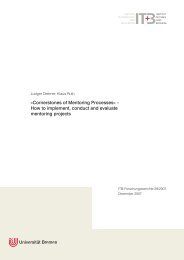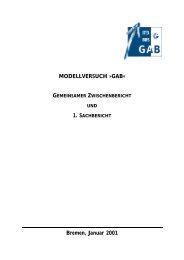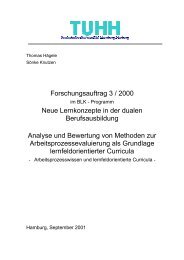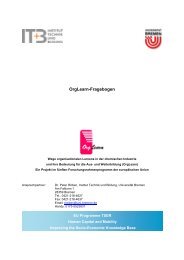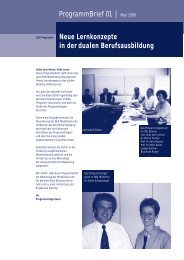VET Teacher Training in Australia: Preserving Australian VET ...
VET Teacher Training in Australia: Preserving Australian VET ...
VET Teacher Training in Australia: Preserving Australian VET ...
Create successful ePaper yourself
Turn your PDF publications into a flip-book with our unique Google optimized e-Paper software.
Level 5 / Diploma: specialised knowledge and skills for skilled/paraprofessional work and/or<br />
further learn<strong>in</strong>g;<br />
Level 6 / Advanced Diploma or Associate Degree: broad knowledge and skills for<br />
paraprofessional/highly skilled work and/or further learn<strong>in</strong>g;<br />
Level 7 / Bachelor Degree: broad and coherent knowledge and skills for professional work<br />
and/or further learn<strong>in</strong>g;<br />
Level 8 / Bachelor Honours Degree or Graduate and Vocational Graduate Certificate or<br />
Graduate and Vocational Graduate Diploma;<br />
Level 9 / Masters Degree: Specialised knowledge and skills for research and/or professional<br />
practice and/or further learn<strong>in</strong>g;<br />
Level 10 / Doctoral Degree: systematic and critical understand<strong>in</strong>g of a complex field of<br />
learn<strong>in</strong>g and specialised research skills for the advancement of learn<strong>in</strong>g and/or for<br />
professional practice.<br />
Although not necessarily worry<strong>in</strong>g, it may come to pass that <strong>VET</strong> as we visibly know it <strong>in</strong> <strong>Australia</strong><br />
evolves (contracts) to <strong>Australia</strong>n Qualification Framework (AQF) levels 1, 2 & 3 be<strong>in</strong>g delivered –<br />
more so than is presently the case ‐<strong>in</strong> secondary schools; and AQF level 6 be<strong>in</strong>g serviced by<br />
universities more so than is presently the case. In these respects, it may come to pass that TAFE<br />
Institutes move away from low AQF levels and move more, than is presently the case, <strong>in</strong>to the higher<br />
education doma<strong>in</strong> along with larger private providers gett<strong>in</strong>g larger through, amongst other<br />
strategies, acquisition of smaller providers; and smaller private providers, who choose to rema<strong>in</strong>,<br />
form<strong>in</strong>g partnerships with secondary schools which are <strong>in</strong>creas<strong>in</strong>g their <strong>VET</strong> <strong>in</strong> Schools 13<br />
engagement. Even beyond <strong>in</strong>creased activity at AQF 6, there is also the possibility that universities<br />
will become more active <strong>in</strong> the <strong>VET</strong> arena <strong>in</strong> response to TAFE Institutes and larger private providers<br />
mov<strong>in</strong>g <strong>in</strong>to the university doma<strong>in</strong> – there are presently four dual sector (i.e. serv<strong>in</strong>g both higher<br />
education and <strong>VET</strong>) universities <strong>in</strong> Victoria.<br />
The effect of the forego<strong>in</strong>g be<strong>in</strong>g that, although the volume of <strong>VET</strong> delivery is likely to expand, the<br />
visible (as previously known) <strong>VET</strong> sector will shr<strong>in</strong>k. If this does happen, the need for <strong>VET</strong> teachers to<br />
be adequately tra<strong>in</strong>ed <strong>in</strong> accord with the particularities of <strong>VET</strong> will still exist, but the seem<strong>in</strong>g<br />
location of <strong>VET</strong> teachers will change; and, hence, they may require additional qualification to the<br />
Certificate IV <strong>in</strong> <strong>Tra<strong>in</strong><strong>in</strong>g</strong> and Assessment as is appropriate to their location of engagement. Some<br />
will be engaged with secondary schools and others will be engaged with universities; and hence a<br />
diffusion of <strong>VET</strong> identity at both ends.<br />
Notwithstand<strong>in</strong>g the correctness of my prediction, the number of <strong>VET</strong> teachers is likely to <strong>in</strong>crease<br />
and the requirement that they are professionally prepared to contribute with vary<strong>in</strong>g levels of<br />
autonomy <strong>in</strong> learn<strong>in</strong>g design and <strong>in</strong>novation capacity will expand. My sense is that <strong>VET</strong> <strong>in</strong> <strong>Australia</strong><br />
has much alignment with the supposedly Swedish proverb “the afternoon knows what the morn<strong>in</strong>g<br />
13 Vet <strong>in</strong> Schools (<strong>VET</strong>iS) was <strong>in</strong>troduced to the Victorian secondary school system <strong>in</strong> 1994 And <strong>in</strong> other States<br />
around this time) as a strategy to add to learn<strong>in</strong>g pathways for senior secondary students and thus <strong>in</strong>crease<br />
the number of students complet<strong>in</strong>g Year 12 (the po<strong>in</strong>t at which secondary education f<strong>in</strong>ishes <strong>in</strong> <strong>Australia</strong>). The<br />
students undertake recognised <strong>VET</strong> studies (typically at Certificate II or Certificate lll level) which count toward<br />
either their Victorian Certificate of Education (VCE – academic pathway) or Victorian Certificate of Applied<br />
Learn<strong>in</strong>g (VCAL). School Based Apprenticeships, where the student has one day <strong>in</strong> the workplace and part of<br />
their learn<strong>in</strong>g facilitated by a <strong>VET</strong> provider, are an aspect of this <strong>in</strong>itiative.<br />
10




